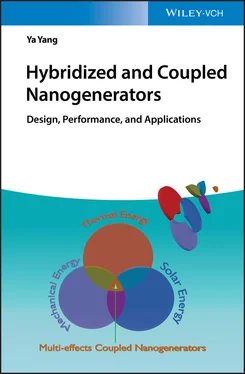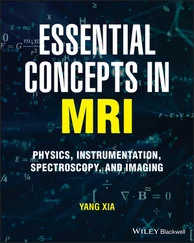Ya Yang - Hybridized and Coupled Nanogenerators
Здесь есть возможность читать онлайн «Ya Yang - Hybridized and Coupled Nanogenerators» — ознакомительный отрывок электронной книги совершенно бесплатно, а после прочтения отрывка купить полную версию. В некоторых случаях можно слушать аудио, скачать через торрент в формате fb2 и присутствует краткое содержание. Жанр: unrecognised, на английском языке. Описание произведения, (предисловие) а так же отзывы посетителей доступны на портале библиотеки ЛибКат.
- Название:Hybridized and Coupled Nanogenerators
- Автор:
- Жанр:
- Год:неизвестен
- ISBN:нет данных
- Рейтинг книги:3 / 5. Голосов: 1
-
Избранное:Добавить в избранное
- Отзывы:
-
Ваша оценка:
- 60
- 1
- 2
- 3
- 4
- 5
Hybridized and Coupled Nanogenerators: краткое содержание, описание и аннотация
Предлагаем к чтению аннотацию, описание, краткое содержание или предисловие (зависит от того, что написал сам автор книги «Hybridized and Coupled Nanogenerators»). Если вы не нашли необходимую информацию о книге — напишите в комментариях, мы постараемся отыскать её.
Hybridized and Coupled Nanogenerators — читать онлайн ознакомительный отрывок
Ниже представлен текст книги, разбитый по страницам. Система сохранения места последней прочитанной страницы, позволяет с удобством читать онлайн бесплатно книгу «Hybridized and Coupled Nanogenerators», без необходимости каждый раз заново искать на чём Вы остановились. Поставьте закладку, и сможете в любой момент перейти на страницу, на которой закончили чтение.
Интервал:
Закладка:
One drawback of natural CNFs is the weak polarization, resulting in low capability to generate surface charges. Introducing different chemical groups to the CNFs could increase the capability. Yao et al. fabricated the CNF film by filtering the hydrogel and then drying, and modified the film by a nitration acid mixture of HNO 3, H 2SO 4, and water [56]. Compared to the pristine CNFs in the corresponding Fourier transform infrared spectroscopy (FTIR) curves, the nitro‐CNFs possessed three new intense peaks due to asymmetric and symmetric stretching of the NO 2group and stretching of the NO bonds. The output voltage signals of the pristine CNF–Cu pair were about 0.8 V and of the nitro‐CNF–Cu pair were about 4.9 V, in the TENGs. Nanostructures on triboelectric materials can increase contacting areas, leading to increased electrostatic charges on these surfaces. Šutka et al. developed highly porous ethyl cellulose (EC) nanostructured films for the TENG [57]. The porous EC films were fabricated by phase inversion of the mixed solution (ethyl cellulose, ethanol, and toluene). The output voltage signals of the TENG based on porous EC films are higher than that of the TENG based on primary EC films. He et al. developed 1D cellulose nanofibers into the pores of cellulose microfibers skeleton, leading to the fabrication of a nanostructured paper, which can be used as template to carry other materials [58].
To boost the electron‐donating tendency of cellulose, Oh et al. fabricated highly conductive ferroelectric cellulose composite papers, which consist of cellulose, silver nanowires, and BaTiO 3nanoparticles [59]. The composite papers were produced through a simple filtration method, with the thickness of the prepared paper of about 70 μm, and were used in the TENG, resulting in high output performances. With the rapid development of printing technique, some researchers explored new methods to fabricate surfaces with micro/nanostructure. Qian et al. developed a biocompatible cellulose‐based TENG through the all‐printing method. The 3D patterned positive layer could be fabricated by printing the CNF ink onto the Ag/PET substrates [60].
2.3.2.2 Metal
Metallic materials, such as copper (Cu) foils, aluminum (Al) foils, and silver (Ag) foils, have been widely used as electrodes of TENGs, which can export the charges generated by the coupling of triboelectric friction and electrostatic induction. Al foils can be used as both a triboelectric layer and an electrode in the TENG due to the high electrical conductivity and the positive position on the triboelectric series. The surface of the Al foil would form positive charges, when it makes contact with the other film with the negative position. Superhydrophobic surfaces emerging from the cooperation of low surface energy and micro/nanostructures are widely explored in biological systems. To increase the surface roughness and environmental stability of the metallic electrodes, Zhao et al. fabricated a superhydrophobic surface on the Al substrates by using chemical etching method [61]. Al substrates were firstly polished to eliminate the dense oxidation on the Al substrates. The polished surface is smooth, as shown in Figure 2.7a,b. The contact angle on the surface is about 62°, as illustrated in Figure 2.7c. After chemical etching, nanostructures are fabricated on the Al substrates, as shown in Figure 2.7d. High magnification SEM of the etched Al substrate shows that protruding structures were formed on the substrate ( Figure 2.7e). The contact angle on the etched Al substrate is about 33°, due to the cooperation of the hydrophilic property of Al and the nanostructures.
By modifying with 1 H ,1 H ,2 H ,2 H ‐perfluorodecyltrichlorosilane/toluene solution, the surface energy of the etched Al substrate could be decreased, leading to the formation of a superhydrophobic surface on the Al substrate. Figure 2.7i shows that the contact angle on the prepared superhydrophobic surface is about 153°. Figure 2.7j shows the values for three different surfaces. Figure 2.7k shows a photograph of water drops with different sizes on the superhydrophobic surface. It is found that the superhydrophobic surface could form positive charges when it made contact with a polyamide film in the TENG.
2.3.2.3 Polymer
Polymers, such as PTFE, FEP, and PDMS, are ideal triboelectric materials for TENGs due to the flexibility and the excellent dielectric property. The surface roughness and environmental stability of the polymers in the TENGs can be enhanced with many advanced methods, such as plasma (ICP)‐reactive ion etching, template method, and 3D printed method. PDMS possesses a great deal of advantages, such as flexibility, transparency, and high electronegativity, and can be easily produced in special shapes. To study the influence of the surface morphology for the TENG, Dudem et al. developed functional polydimethylsiloxane (NpA‐PDMS) layers by soft imprint lithography [62]. The prepared layers possessed nanopillar‐like architectures, which could be used to increase the output voltage of the TENG.
PTFE is a common negative triboelectric material, exhibiting strong electron‐attracting ability and excellent flexibility. Guo et al. utilized inductively coupled plasma (ICP) ion etching to produce nanostructures on the PTFE film [63]. The fabricated PTFE film could form more charges when it made contact with the electrode, resulting in high output performance of the TENG. Wang et al. fabricated sponge‐like porous PTFE thin films by using deionized (DI) water as the soft template [64]. Compared with that based on flat PTFE film, the output performance based on porous PTFE thin film was obviously enhanced. Zhao et al. fabricated polytetrafluoroethylene/polyethene oxide (PTFE/PEO) membranes by using electrospinning method. In order to further enhance the charge density on the composite membranes, they introduced a high amount of stable static negative charges on the surface of the membranes [65].

Figure 2.7Superhydrophobic surfaces on the Al substrates. (a) SEM image of the polished Al substrate. (b) High magnification SEM image of the polished Al substrate. (c) Image of the contact angle of water on the polished Al substrate. (d) SEM image of the etched Al substrate. (e) High‐magnification SEM image of the etched Al substrate. (f) Image of the contact angle of water on the etched Al substrate. (g) SEM image of the etched Al substrate modified with low surface energy material. (h) High‐magnification SEM image of the modified Al substrate. (i) Image of the contact angle of water on the modified Al substrate. (j) Measured contact angles of three different Al surfaces. (k) Photograph of the water drops on the superhydrophobic surface.
Source: Reproduced with permission from Zhao et al. [61]. Copyright 2016, American Chemical Society.
2.3.2.4 Nanoparticle and Nanowire
Nanoscale materials including nanoparticles and nanowires have attracted broad interest due to their unique chemical and physical characteristics. Unlike bulk materials, reducing the size of materials to the nanoscale could make them exhibit high reactivity. Nanoparticles (NPs) with high surface energy can be easily re‐formed into functional materials, and nanowires (NWs) offer high surface area and restrain the mechanical degradation [66]. These nanoscale materials have been widely used in applications of energy collecting and storing devices.
NWs with high surface area that restrain the mechanical degradation could be used to optimize the performance of TENGs. Jiang et al. developed a Ag nanowire‐based TENG, where Ag nanowires were used as both triboelectric layers and electrodes. Ag nanowires were fabricated through a polyol synthesis method [67]. Figure 2.8a,b shows that the diameter and length of the nanowire are about 70 nm and 10 μm, respectively. Photographic paper was used as the substrate to fix the Ag nanowire slurry, resulting in a metal electrode with excellent conductivity ( Figure 2.8c). The Ag nanowires closely accumulate on the photographic paper to form the Ag nanowires membrane, as shown in Figure 2.8d. Cheon et al. fabricated PVDF–Ag NW composite by the electrospinning method. The electrostatic interactions between the Ag NWs and the dipoles of the PVDF chains could promote β‐phase crystal formation of PVDF, which can be further used to increase the output performance of the TENGs [68]. From a triboelectric perspective, NPs could increase the surface roughness and dielectric property of friction films, leading to enhanced performances of TENGs. Jiang et al. reported a Ag nanoparticle‐based TENG, where Ag nanoparticles were used as both triboelectric layers and electrodes [69]. Ag nanoparticles with a diameter of about 50 nm were fabricated through an ice−water bath method as shown in Figure 2.8e. The Ag nanoparticles were stuck on the photographic paper to form the Ag membrane, increasing the mechanical stability of nanoparticles, as shown in Figure 2.8f. It is found that the membrane could form positive charges when it made contact with a FEP film in the TENG.
Читать дальшеИнтервал:
Закладка:
Похожие книги на «Hybridized and Coupled Nanogenerators»
Представляем Вашему вниманию похожие книги на «Hybridized and Coupled Nanogenerators» списком для выбора. Мы отобрали схожую по названию и смыслу литературу в надежде предоставить читателям больше вариантов отыскать новые, интересные, ещё непрочитанные произведения.
Обсуждение, отзывы о книге «Hybridized and Coupled Nanogenerators» и просто собственные мнения читателей. Оставьте ваши комментарии, напишите, что Вы думаете о произведении, его смысле или главных героях. Укажите что конкретно понравилось, а что нет, и почему Вы так считаете.












